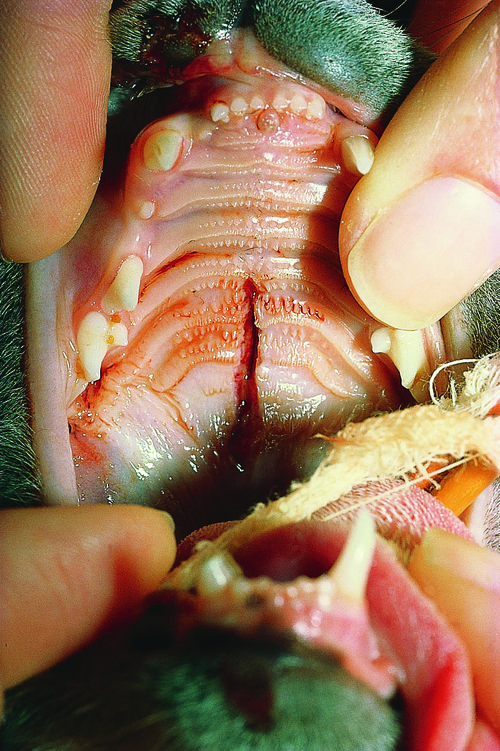Difference between revisions of "Veterinary Dentistry Q&A 16"
(Created page with "[[|centre|500px]] <br /> <br /> <FlashCard questions="3"> |q1=This is an example of a traumatic condition, commonly seen in the cat. What is it, and what syndrome can it be p...") |
|||
| (2 intermediate revisions by 2 users not shown) | |||
| Line 1: | Line 1: | ||
| − | [[|centre|500px]] | + | {{Template:Manson |
| + | |book = Veterinary Dentistry Q&A}} | ||
| + | |||
| + | [[File:Vet Dentistry 16.jpg|centre|500px]] | ||
<br /> | <br /> | ||
| Line 15: | Line 18: | ||
A cat usually falls in a splayed-leg position and lands on all four limbs; the head then | A cat usually falls in a splayed-leg position and lands on all four limbs; the head then | ||
bounces against the landing surface. | bounces against the landing surface. | ||
| − | |l1= | + | |l1=High-Rise Syndrome |
|q2=What are the other possible maxillofacial components of this syndrome? | |q2=What are the other possible maxillofacial components of this syndrome? | ||
|a2= | |a2= | ||
| Line 22: | Line 25: | ||
#Mandibular fractures, in particular mandibular symphysis separation. | #Mandibular fractures, in particular mandibular symphysis separation. | ||
#Temporomandibular joint luxation and fracture of the condyloid process. | #Temporomandibular joint luxation and fracture of the condyloid process. | ||
| − | |l2= | + | |l2=High-Rise Syndrome |
|q3=What are the treatment options for this specific injury? | |q3=What are the treatment options for this specific injury? | ||
|a3= | |a3= | ||
| Line 30: | Line 33: | ||
However, occasionally this healing does not take place and a persistent oronasal fistula results; the latter condition is far more difficult to manage. | However, occasionally this healing does not take place and a persistent oronasal fistula results; the latter condition is far more difficult to manage. | ||
| − | |l3= | + | |l3=High-Rise Syndrome#Treatment |
</FlashCard> | </FlashCard> | ||
Latest revision as of 16:29, 15 October 2011
| This question was provided by Manson Publishing as part of the OVAL Project. See more Veterinary Dentistry Q&A. |
| Question | Answer | Article | |
| This is an example of a traumatic condition, commonly seen in the cat. What is it, and what syndrome can it be part of? | A traumatic cleft of the hard palate, which can be part of the so-called high-rise syndrome. This syndrome describes the injuries sustained, mainly by cats, falling at least two stories. Contrary to dogs, the survival rate in cats is high under such circumstances. A cat usually falls in a splayed-leg position and lands on all four limbs; the head then bounces against the landing surface. |
Link to Article | |
| What are the other possible maxillofacial components of this syndrome? |
|
Link to Article | |
| What are the treatment options for this specific injury? | Traumatic cleft of the hard palate in the cat can easily and effectively be managed by approximating the displaced bony structures by gentle digital pressure, followed by suturing of the torn palatal soft tissues in a simple interrupted pattern. Flushing and suctioning the nasal cavity is indicated if large blood clots are present, which may have a marked beneficial effect on the habitus and appetite of the patient. The benefit of this initial management outweighs the risk inherent in leaving this injury to heal by second intention, although this has been shown to be sufficient in most cases. However, occasionally this healing does not take place and a persistent oronasal fistula results; the latter condition is far more difficult to manage. |
Link to Article | |
